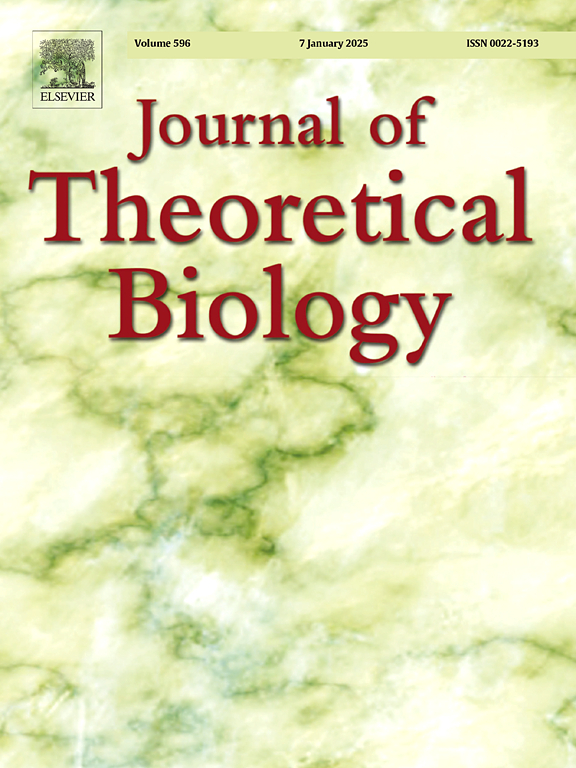Absorbing Markov chain model of PrEP drug adherence to estimate adherence decay rate and probability distribution in clinical trials
IF 1.9
4区 数学
Q2 BIOLOGY
引用次数: 0
Abstract
Pre-exposure prophylaxis (PrEP) is increasingly used to prevent the transmission of H.I.V. in at-risk populations. However, PrEP users may discontinue use of the medicine due to side effects, lower perceived risk, or other reasons. The usage metrics of 594 individuals was tracked over 350 days using the Wisepill electronic monitoring system. We model the PrEP drug adherence level using an absorbing Markov chain with a unique absorbing state. The transition matrix obtained from the Wisepill data will have a trivial eigenvector (eigendistribution) associated with the first (i.e., largest) eigenvalue 1. The 2nd eigenvalue(s) then become important in determining the asymptotic behavior of the Markov chain, dictating how fast the Markov chain decays to the absorbing state. Under a fairly general assumption, we prove that the second positive eigenvalue is unique and the corresponding eigenvector will have nonnegative entries with exceptions at absorbing states. In addition, we define the asymptotic half life of the absorbing Markov chain directly from the 2nd eigenvalue. We then determine the 2nd eigenvalue of and the asymptotic half life of the Markov chain, which turns out to be very close to the real half life of the Markov chain. Finally, we interpret the 2nd eigenvector as the relative probability distribution of with respect to the decay rate of the 2nd eigenvalue. By applying these methods to the Wisepill data, we estimate the half-life of population adherence to be 46 weeks. The bi-weekly decay rate observed in these data from 90 to 100 % adherence is 3 %. This work produces an estimate at which adherence falls over time, given no external intervention is applied. These results suggest an eigenvector-based approach to estimate adherence trends, as well as the timing of interventions to improve adherence.
引入PrEP药物依从性的马尔可夫链模型,估计临床试验中依从性衰减率和概率分布
暴露前预防(PrEP)越来越多地用于预防艾滋病毒在高危人群中的传播。然而,PrEP使用者可能由于副作用、较低的感知风险或其他原因而停止使用药物。使用Wisepill电子监控系统,对594人的使用指标进行了350天的跟踪。我们使用具有独特吸收状态的吸收马尔可夫链来模拟PrEP药物依从性水平。从Wisepill数据获得的转移矩阵T将具有与第一个(即最大)特征值1相关的平凡特征向量(特征分布)。然后,第二个特征值在确定马尔可夫链的渐近行为中变得重要,它决定了马尔可夫链衰减到吸收态的速度。在一个相当一般的假设下,我们证明了第二个正特征值是唯一的,并且相应的特征向量除了在吸收态有例外,都有非负项。此外,我们直接从第二个特征值定义了吸收马尔可夫链的渐近半衰期。然后我们确定了T的第二个特征值和马尔可夫链的渐近半衰期,它与马尔可夫链的实际半衰期非常接近。最后,我们将第二个特征向量解释为X∞相对于第二个特征值衰减率的相对概率分布。通过将这些方法应用于Wisepill数据,我们估计人群依从性的半衰期为46周。在这些数据中,从90%到100%的依从性观察到的双周衰减率为3%。这项工作产生了一个估计,在没有外部干预的情况下,依从性随着时间的推移而下降。这些结果建议采用基于特征向量的方法来估计依从性趋势,以及改善依从性的干预时机。
本文章由计算机程序翻译,如有差异,请以英文原文为准。
求助全文
约1分钟内获得全文
求助全文
来源期刊
CiteScore
4.20
自引率
5.00%
发文量
218
审稿时长
51 days
期刊介绍:
The Journal of Theoretical Biology is the leading forum for theoretical perspectives that give insight into biological processes. It covers a very wide range of topics and is of interest to biologists in many areas of research, including:
• Brain and Neuroscience
• Cancer Growth and Treatment
• Cell Biology
• Developmental Biology
• Ecology
• Evolution
• Immunology,
• Infectious and non-infectious Diseases,
• Mathematical, Computational, Biophysical and Statistical Modeling
• Microbiology, Molecular Biology, and Biochemistry
• Networks and Complex Systems
• Physiology
• Pharmacodynamics
• Animal Behavior and Game Theory
Acceptable papers are those that bear significant importance on the biology per se being presented, and not on the mathematical analysis. Papers that include some data or experimental material bearing on theory will be considered, including those that contain comparative study, statistical data analysis, mathematical proof, computer simulations, experiments, field observations, or even philosophical arguments, which are all methods to support or reject theoretical ideas. However, there should be a concerted effort to make papers intelligible to biologists in the chosen field.

 求助内容:
求助内容: 应助结果提醒方式:
应助结果提醒方式:


